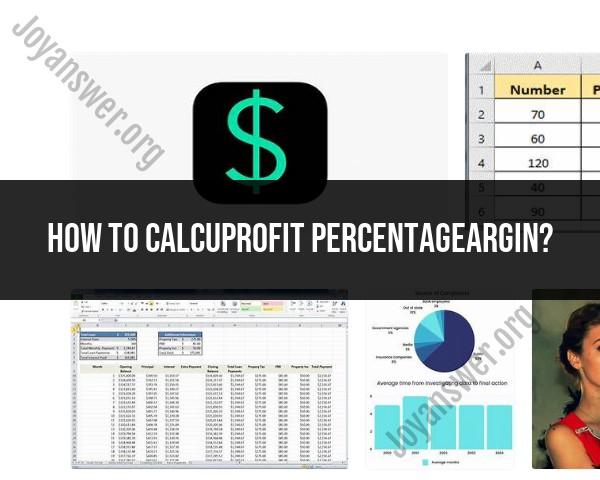How to calcuprofit percentageargin?
Calculating the profit margin percentage is an essential aspect of understanding your business's financial health. It shows what percentage of revenue is profit after accounting for expenses. Here's a step-by-step guide on how to calculate the profit margin percentage:
1. Understanding Key Terms
- Revenue (Sales): The total amount of money generated from selling goods or services.
- Cost of Goods Sold (COGS): The direct costs attributable to the production of the goods sold by a company. This includes the cost of materials and labor directly used to create the product.
- Gross Profit: Revenue minus COGS.
- Operating Expenses: The expenses required for running the business that are not directly tied to the production of goods or services, such as rent, utilities, and salaries.
- Net Profit: Revenue minus all expenses (COGS, operating expenses, taxes, interest, etc.).
2. Types of Profit Margins
There are primarily three types of profit margins:
- Gross Profit Margin
- Operating Profit Margin
- Net Profit Margin
3. Formulas
Gross Profit Margin
Gross Profit Margin shows the percentage of revenue that exceeds the COGS. It indicates how efficiently a company is producing its goods.
Where:
Operating Profit Margin
Operating Profit Margin shows the percentage of revenue that remains after covering operating expenses. It provides insight into the company’s operational efficiency.
Where:
Net Profit Margin
Net Profit Margin shows the percentage of revenue that remains as profit after all expenses are accounted for. It provides the most comprehensive view of profitability.
Where:
4. Step-by-Step Calculation
Example:
Let's say your business has the following financial figures for a given period:
- Revenue: $500,000
- COGS: $300,000
- Operating Expenses: $100,000
- Taxes: $20,000
- Interest: $10,000
Gross Profit Margin Calculation
Calculate Gross Profit:
Calculate Gross Profit Margin:
Operating Profit Margin Calculation
Calculate Operating Profit:
Calculate Operating Profit Margin:
Net Profit Margin Calculation
Calculate Net Profit:
Calculate Net Profit Margin:
Summary
- Gross Profit Margin: 40%
- Operating Profit Margin: 20%
- Net Profit Margin: 14%
Understanding these margins helps you assess various aspects of your business's financial health, such as production efficiency, operational effectiveness, and overall profitability.
How is the profit percentage margin calculated in business?
There are two main profit margin metrics used in business to measure profitability: gross profit margin and net profit margin. Both are expressed as a percentage of total revenue.
Gross Profit Margin:
This metric shows the profit a business makes after accounting for the direct costs of producing the goods or services it sells. It reflects how efficiently a business is converting its sales into gross profit.
Here's the formula for gross profit margin:
- Gross Profit Margin = (Gross Profit / Revenue) x 100
Where:
- Gross Profit: This is the difference between the revenue from sales and the cost of goods sold (COGS). COGS includes the direct costs of materials, labor, and overhead directly involved in producing the good or service.
Net Profit Margin:
This metric represents the overall profitability of the business. It takes into account all business expenses, not just the cost of goods sold. Net profit margin shows what percentage of each dollar of revenue remains as net profit after accounting for all business costs.
Here's the formula for net profit margin:
- Net Profit Margin = (Net Profit / Revenue) x 100
Where:
- Net Profit: This is the final profit figure after subtracting all business expenses from the total revenue. Expenses include COGS, operating expenses (rent, salaries, marketing, etc.), interest, and taxes.
Example:
Let's say a business has the following figures:
- Revenue: $100,000
- Cost of Goods Sold (COGS): $60,000
- Operating Expenses: $20,000
- Interest: $5,000
- Taxes: $5,000
Gross Profit Margin Calculation:
- Gross Profit = Revenue - COGS = $100,000 - $60,000 = $40,000
- Gross Profit Margin = ($40,000 / $100,000) x 100 = 40%
Net Profit Margin Calculation:
- Net Profit = Revenue - (COGS + Operating Expenses + Interest + Taxes)= $100,000 - ($60,000 + $20,000 + $5,000 + $5,000) = $10,000
- Net Profit Margin = ($10,000 / $100,000) x 100 = 10%
In this example, the business has a 40% gross profit margin, meaning they capture 40 cents of profit for every dollar of sales after covering the cost of producing the goods. However, their net profit margin is only 10%, indicating that a significant portion of their revenue is consumed by operating expenses, interest, and taxes.











